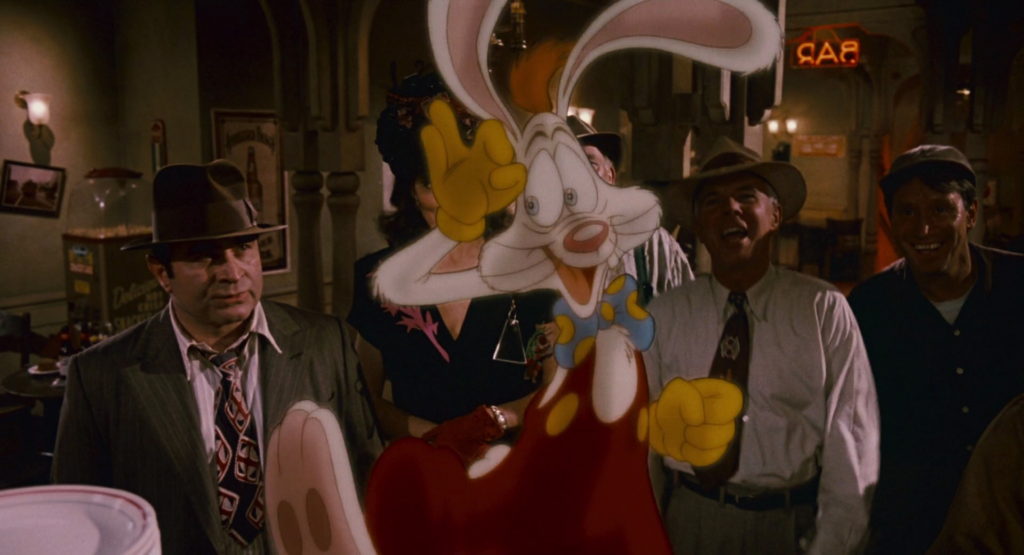By far one of the most unique and inimitable films ever made was Who Framed Roger Rabbit (1988). Not quite a children’s film and certainly not an adult drama, it was quite the visual spectacle in 1988. By now, the stories of how two rival studios hammered out terms of engagement so that the film could be produced are legendary. Both insisted that their top stars get equal screen time, but iconic animator Chuck Jones storyboarded the confrontation between Donald and Daffy, which is probably why it is more memorable than the meet up between the mouse and bunny.
Roger Rabbit has all the needed ingredients for a classic family movie, but its script is more complex than typical afternoon matinee offerings. For one thing, it has roots in historic fact. No, “Toontown” never existed, but the endangered cable car line that was phased out of existence in and out of Los Angeles in favor of highways for auto traffic did.
The subtext of animated denizens of California being treated as inferior minorities by their living, breathing fellow co-inhabitants may be lost on kids, but will certainly register as still timely by adults. The book that the film is based on is similar to the old noir classic D.O.A (1949) while director Robert Zemeckis adapted it to be more like Roman Polanski’s Chinatown (1974), complete with a femme fatale that is drawn to be bad.
While parents can enjoy the grittier aspects of Roger Rabbit it can also be a great taking off point to introduce their children to some of the more obscure critters who make cameos in the film. Given the recent quarantine and options for kid pleasing content dwindling, delving into the past might be the perfect strategy. The following is a short list of suggested cartoon characters to look for while scrolling through streaming services with family members.
Betty Boop
Poor Betty is seen waiting tables at the Ink & Paint Club in Roger Rabbit. She is drawn in black and white while all the other “toons” around her are in color. Max Fleischer created Betty in the 1930’s as a homage to the swinging flapper girls of the previous decade. She was at the height of her popularity in the early days of animation when she even gave a certain mouse competition. Her cartoons are still fun to watch today, but look for Minnie the Moocher (1932) which featured the voice of Cab Calloway as a scat singing ghost. It’s a great showcase for the creative innovations that made Max Fleischer a rival of Walt Disney.
Three Little Pigs
Speaking of Disney, he started out creating short animated films under the umbrella title of “Silly Symphonies” in 1929. One of the most popular of these cinematic whimsies was The Three Little Pigs (1933). We see the trio singing as Detective Eddie Valiant (Bob Hoskins) drives into Toontown. This is totally appropriate since the porcine threesome are remembered for their hit song, “Who’s Afraid of the Big, Bad Wolf?” The film was a huge hit and the song became an inspiration to Americans facing the Great Depression. Be warned, it’s likely to become an earworm for days. The animation itself is charming with each piggy hero having their own unique personality.
Tweety
This little bird joined the Warner Brothers animated gang in 1942, though an earlier version can be traced to a year previous. Tweety can be seen in Roger Rabbit being a naughty boy terrorizing Eddie Valiant as he hangs on for dear life in Toontown. In the Warner Brothers’ canon, Tweety is often eclipsed in popularity by the bigger star leads of Bugsy and Daffy. However, his adventures foiling the nefarious plans of his nemesis, Sylvester the Cat can be just as much fun to introduce to young viewers. Voice actor Mel Blanc was brilliant in creating the personalities for most of the Looney Toons characters, but with Tweety, he was particularly iconic. The little bird’s description of Sylvester as a “putty tat” has become part of the vernacular. Worth seeking out is the short titled, Putty Tat Trouble, where Tweety sings about himself and the challenges of avoiding becoming a late-night snack for felines.
Droopy Poodle
In hot pursuit of Roger’s (Charles Fleischer) rabbitnappers, Eddie Valiant jumps into an elevator only to find that it is operated by Droopy Poodle. Created by the legendary animator Tex Avery, Droopy was part of the MGM stable of cartoon characters, but Tom and Jerry were more popular for the studio. To paraphrase Shakespeare, though Droopy be little, he is fierce. Deadpan in his reactions to adversaries, he is nonetheless much stronger than he looks. For an example of what happens when he an announces that something makes him mad, check out One Droopy Knight (1957).
Woody Woodpecker
As one of the denizens of Toontown relieved to find that both Roger and his lovely bride, Jessica (Kathleen Turner) are safe in the big closing scene of Roger Rabbit, Woody Woodpecker is spotted mingling with the likes of Mickey, Goofy and Daffy. Walter Lantz created Woody for Universal Studios in the 1940’s and his cartoons were in production continuously into the 70’s. Woody got his own theme song in 1948, which heavily featured his famous laugh. None other than voice wizard Mel Blanc came up with the divisive giggle, which will either have audiences join in or jab at the mute button on the television remote. Episodes of Woody’s television cartoons have been in syndication since the 1960’s and can easily be found.

